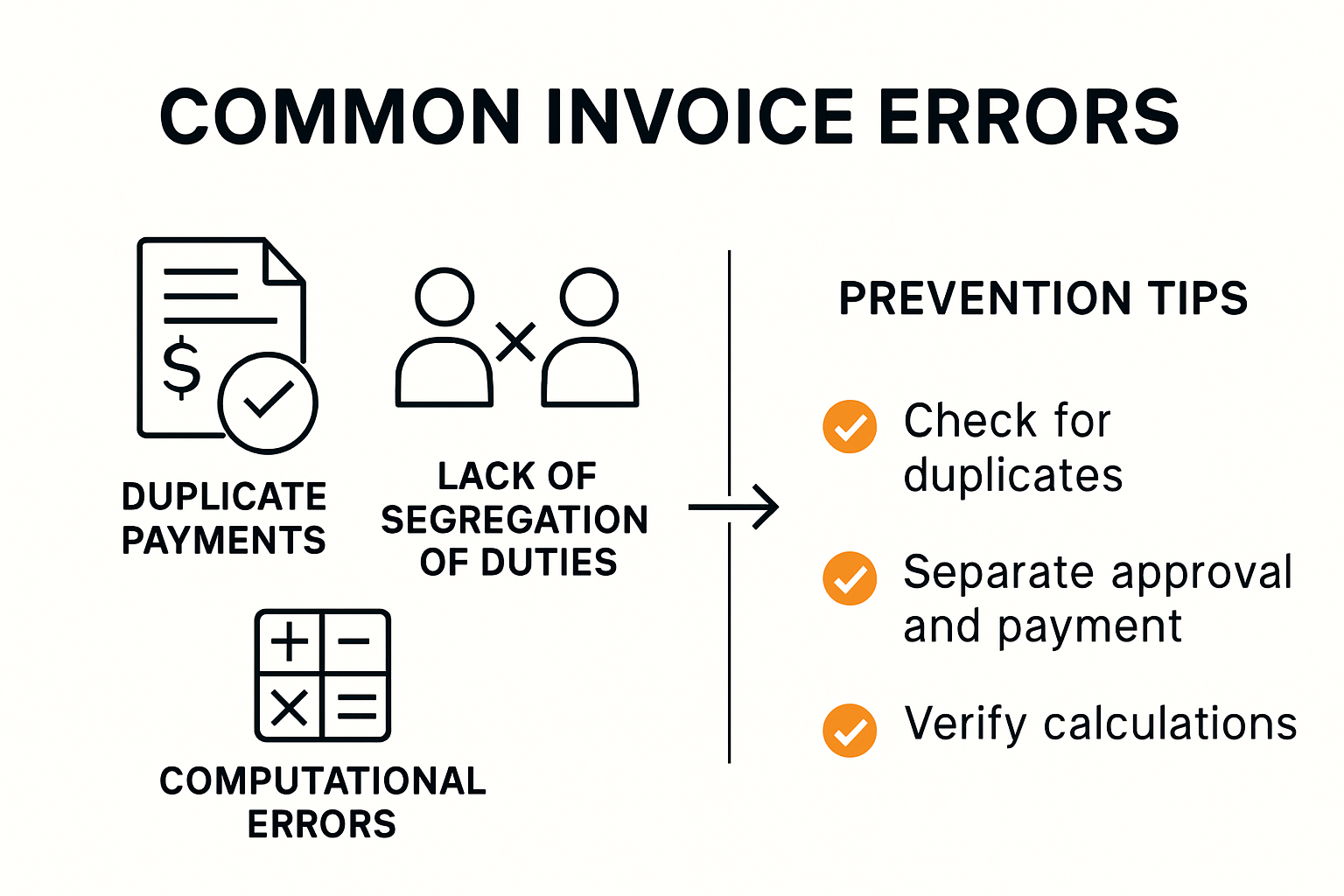Every invoice that passes through a company’s accounts seems straightforward and yet buried mistakes can cost businesses a fortune. Here is what surprises most people. A recent audit found that 73% of invoices lacked adequate scrutiny, leaving huge gaps for errors and losses. Instead of letting small slips drain profits, a smart invoice audit checklist puts your business back in control and prevents those hidden risks from snowballing.

Invoice Audit Checklist: Key Steps for Accurate Reviews
Table of Contents
- Understanding The Importance Of Invoice Audits
- Step-By-Step Invoice Audit Checklist For Teams
- Common Errors And How To Prevent Them
- Tips For Streamlining Your Invoice Audit Process
Quick Summary
| Takeaway | Explanation |
|---|---|
| Conduct thorough invoice audits | Ensure detailed reviews to detect errors and discrepancies effectively. |
| Implement automated verification systems | Use technology to reduce manual errors and streamline invoice processing. |
| Establish standardized audit protocols | Consistency in review procedures enhances accuracy and accountability. |
| Focus on document management | Efficient archiving and retrieval support future audits and financial reviews. |
| Mitigate duplicate payment risks | Utilize checks to prevent processing the same invoice multiple times. |
Understanding the Importance of Invoice Audits
Invoice audits represent a critical financial safeguard for businesses seeking to maintain fiscal accuracy and prevent potential financial losses. By systematically reviewing invoices, organizations can detect errors, uncover discrepancies, and ensure precise financial record keeping.
Financial Risk Mitigation
The stakes of overlooking invoice details are significant. According to a study by the Tennessee Valley Authority’s Office of the Inspector General, 73% of reviewed invoices lacked adequate scrutiny, revealing substantial vulnerabilities in financial processes. These vulnerabilities can manifest as overcharging, duplicate billing, computational errors, or unauthorized expenses.

Key financial risks include:
- Undetected billing errors
- Potential vendor fraud
- Unnecessary financial leakage
- Inaccurate budget allocations
Compliance and Operational Efficiency
Beyond financial protection, invoice audits serve crucial compliance functions. Research published by the National Center for Biotechnology Information emphasizes how detailed invoice reviews enable organizations to analyze staffing models, compare total revenue against expenses, and maintain robust financial stability.
Effective invoice auditing goes beyond mere number checking. It involves a comprehensive examination of contractual terms, vendor performance, and alignment with organizational spending policies. By implementing a rigorous invoice parsing strategy, businesses can transform these reviews from a mundane administrative task into a strategic financial management tool.
The process demands meticulous attention to detail, systematic documentation, and a proactive approach to identifying and rectifying potential financial discrepancies. Organizations that prioritize thorough invoice audits position themselves to protect their financial integrity, optimize spending, and maintain transparent, accountable financial operations.
Step-by-Step Invoice Audit Checklist for Teams
Navigating the complexities of invoice auditing requires a systematic approach that empowers teams to conduct thorough and efficient financial reviews. Developing a comprehensive invoice audit checklist helps organizations minimize errors, reduce financial risks, and maintain precise accounting records.
Preliminary Document Preparation
Before diving into the audit process, teams must establish a robust preparation framework. According to the U.S. Government Accountability Office (GAO) Financial Audit Manual, proper documentation and organizational systems are fundamental to successful financial audits. This initial stage involves gathering all relevant invoices, purchase orders, contracts, and supporting financial documentation.
Key preparation steps include:
- Collecting all invoice documents chronologically
- Verifying document completeness and legibility
- Creating a centralized digital repository for audit materials
- Establishing clear access protocols for audit team members
Systematic Invoice Verification Process
The core of an effective invoice audit lies in methodical verification. The GAO’s Prompt Payment Act audit procedures recommend a structured approach to evaluating financial transactions. Teams should develop a consistent methodology for reviewing each invoice, focusing on critical validation points.
Essential verification steps encompass:
- Cross-referencing invoice amounts with original purchase orders
- Confirming vendor details and payment terms
- Checking mathematical accuracy of calculations
- Validating tax calculations and applicable rates
- Ensuring compliance with internal spending policies
Teams can enhance their audit efficiency by exploring advanced invoice parsing techniques that automate detailed document reviews and flag potential discrepancies.
Final Review and Reconciliation
The final stage of the invoice audit involves comprehensive reconciliation and reporting. This phase requires meticulous attention to detail, comparing audit findings against original financial records and identifying any significant variations. Successful teams develop clear reporting mechanisms that document discovered discrepancies, potential cost-saving opportunities, and recommendations for process improvement.
Effective reconciliation includes:
- Generating detailed audit reports
- Documenting and categorizing identified discrepancies
- Communicating findings with relevant financial stakeholders
- Developing corrective action plans for systemic issues
By implementing a structured invoice audit checklist, organizations can transform financial review from a reactive task into a proactive strategy for maintaining fiscal integrity and operational efficiency.
For teams establishing an effective invoice audit procedure, the following table outlines the critical steps in preparing, verifying, and reconciling invoices, based directly on the process described in the article.
| Audit Stage | Actions Involved |
|---|---|
| Preliminary Document Preparation | Gather all invoices, purchase orders, contracts; verify completeness and legibility; create a centralized repository; control team access |
| Systematic Invoice Verification | Cross-check amounts with purchase orders; confirm vendor details; verify calculations and tax; ensure policy compliance |
| Final Review and Reconciliation | Generate audit report; document discrepancies; communicate findings; develop corrective actions |
Common Errors and How to Prevent Them
Invoice processing is fraught with potential pitfalls that can compromise financial accuracy and organizational efficiency. Understanding these common errors and implementing strategic prevention mechanisms is crucial for maintaining fiscal integrity.

Duplicate Payment Risks
According to the Association of Certified Accounts and Reporting Professionals, duplicate invoices represent a significant financial vulnerability. These errors occur when the same invoice is inadvertently processed multiple times, leading to unnecessary financial outflows and complex reconciliation challenges.
Primary causes of duplicate payments include:
- Manual data entry errors
- Inconsistent invoice tracking systems
- Lack of centralized invoice management
- Ineffective cross-referencing mechanisms
Prevention strategies involve implementing automated invoice verification systems that cross-check invoice numbers against existing payment records, ensuring each invoice is processed only once.
Internal Control and Segregation of Duties
The U.S. Government Accountability Office emphasizes the critical importance of proper segregation of duties in financial processes. Concentrating too much financial authority within a single role creates significant risk for potential errors and fraudulent activities.
Effective prevention requires:
- Distributing financial responsibilities across multiple team members
- Establishing clear approval hierarchies
- Creating independent review mechanisms
- Implementing robust verification checkpoints
Teams can explore advanced invoice parsing techniques to introduce additional layers of automated verification and reduce human error potential.
Computational and Data Accuracy Challenges
Financial calculations represent another critical area prone to errors. Seemingly minor computational mistakes can cascade into significant financial discrepancies if left undetected. Common computational errors include incorrect tax calculations, misapplied discount rates, and arithmetic mistakes during manual data entry.
Key prevention approaches involve:
- Utilizing automated calculation verification tools
- Implementing real-time error detection systems
- Establishing mandatory double-checking protocols
- Developing standardized calculation templates
By proactively addressing these common invoice processing errors, organizations can significantly reduce financial risks, improve operational efficiency, and maintain precise financial records. The investment in robust error prevention mechanisms ultimately translates into substantial long-term cost savings and enhanced financial management capabilities.
To help you quickly spot and prevent invoice errors, here’s a summary table of common invoice processing mistakes and suggested prevention strategies mentioned in the article.
| Common Error | Description | Key Prevention Strategy |
|---|---|---|
| Duplicate Payment | Processing the same invoice multiple times | Automated verification and cross-referencing |
| Manual Data Entry Errors | Typing mistakes during invoice input | Centralized and automated invoice management |
| Inconsistent Tracking | Poor tracking due to lack of standardized system | Implement standardized tracking systems |
| Lack of Segregation of Duties | Excess financial authority concentrated in one role | Distribute responsibilities and establish approval hierarchy |
| Computational Mistakes | Math errors or incorrect tax/discount calculation | Use automated calculation tools and mandatory double-checks |
| Poor Document Management | Missing or incomplete documentation | Digitize and centralize invoice storage |
Tips for Streamlining Your Invoice Audit Process
Streamlining the invoice audit process requires strategic approaches that balance efficiency, accuracy, and technological integration. By implementing targeted strategies, organizations can transform complex financial reviews into smooth, systematic workflows that minimize errors and maximize productivity.
Technological Integration and Automation
According to LinkedIn’s professional insights, modern invoice auditing demands sophisticated technological solutions. Automation tools can dramatically reduce manual processing time and eliminate human error risks.
Key technological strategies include:
- Implementing AI-powered invoice parsing systems
- Using optical character recognition (OCR) for document scanning
- Integrating real-time validation checks
- Developing automated cross-referencing mechanisms
Teams can explore advanced invoice processing techniques that leverage machine learning to enhance accuracy and speed.
Standardized Review Protocols
Ramp’s comprehensive audit process emphasizes the importance of establishing consistent review protocols. Standardization ensures that every invoice undergoes a uniform, thorough examination regardless of the team member conducting the audit.
Essential standardization components involve:
- Creating detailed audit checklists
- Developing clear approval hierarchies
- Establishing uniform documentation standards
- Implementing consistent verification checkpoints
Document Management and Archiving
Bill.com’s financial resource guidelines highlight the critical role of systematic document management in streamlining invoice audits. Efficient archiving and retrieval systems are fundamental to maintaining audit trails and supporting future financial reviews.
Effective document management strategies include:
- Digitizing all physical invoice documents
- Creating searchable, well-organized digital repositories
- Implementing secure cloud storage solutions
- Establishing clear retention and deletion protocols
By integrating these comprehensive approaches, organizations can transform their invoice audit processes from time-consuming administrative tasks into strategic, efficient financial management practices. The key lies in combining technological innovation, standardized protocols, and robust document management systems to create a seamless, accurate review workflow.
Frequently Asked Questions
What is the purpose of an invoice audit checklist?
An invoice audit checklist helps ensure thorough reviews of invoices to detect errors, discrepancies, and compliance issues, thereby protecting a company’s financial integrity.
What common errors should I look for during an invoice audit?
Common errors include duplicate payments, manual data entry mistakes, computational errors, inconsistencies in tracking, and lack of proper document management.
How can technology improve the invoice audit process?
Technology can enhance the invoice audit process through automation tools that streamline data entry, implement real-time validation checks, and utilize AI-powered systems for more accurate document reviews.
What are the key steps in a systematic invoice verification process?
Key steps include cross-referencing invoice amounts with purchase orders, confirming vendor details, checking mathematical accuracy, validating tax calculations, and ensuring compliance with internal spending policies.
Transform Your Invoice Audits Into Seamless Smart Workflows
Struggling with hidden errors, duplicate payments, or manual data entry hassles as described in the article? If building a reliable invoice audit checklist is overwhelming your team and slowing your financial reviews, it may be time to experience stress-free automation. Invoice Parse empowers you to instantly extract and verify every key invoice detail using advanced AI. Audit pain vanishes when you upload PDFs or images and let smart technology handle calculations, vendor checks, and line-item extraction for you. No more wasted hours. No tedious templates to maintain. Only fast, accurate results you can trust.

See for yourself how effortless invoice auditing can be. Visit Invoice Parse and start uploading your invoices today. Take advantage of real-time analysis, easy exporting to tools like Excel or Power BI, and flexible team subscription plans designed to fit your growing needs. Want to learn more about our drag-and-drop solution or integration process? Explore in-depth features and get started now at Invoice Parse. Rapid improvement in your audit process is just a click away.
Recommended
- AI Invoice Parse – Upload Invoice Guide: Step-by-Step Instructions for 2025
- AI Invoice Parse – Line Invoice Guide: Everything You Need to Know in 2025
- AI Invoice Parse – Invoice Approval Workflow: Steps, Best Practices, and Tools
- AI Invoice Parse – The Ultimate Guide to Invoice Items for Beginners 2025
- Odoo accounting, benefits & features of Odoo accounting
